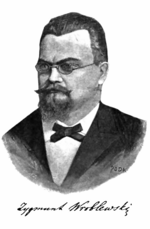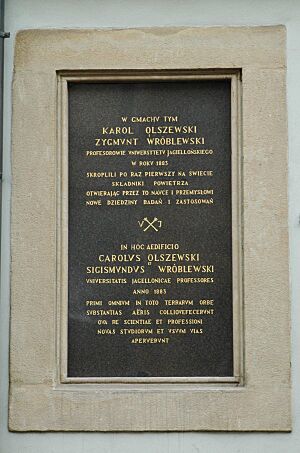Zygmunt Florenty Wróblewski facts for kids
Quick facts for kids
Zygmunt Florenty Wróblewski
|
|
|---|---|

Zygmunt Florenty Wróblewski
|
|
| Born | 28 October 1845 |
| Died | 16 April 1888 (aged 42) |
| Nationality | Polish |
| Alma mater | Kiev University Munich University |
| Known for | condensation liquefaction |
| Scientific career | |
| Fields | Chemistry Physics |

Zygmunt Florenty Wróblewski (born October 28, 1845 – died April 16, 1888) was a brilliant Polish scientist. He was both a physicist (someone who studies how things work in the universe) and a chemist (someone who studies what things are made of). With his friend Karol Olszewski, he made a huge discovery in 1883. They were the first scientists ever to turn nitrogen gas into a liquid! This was a big step in understanding how matter behaves.
Contents
Early Life and Education
Zygmunt Wróblewski was born in Grodno, a city that is now in Belarus. When he was young, he went to Kiev University to study.
A Difficult Time
Life wasn't always easy for Zygmunt. He was involved in the January Uprising in 1863. This was a fight for freedom against the Russian Empire. Because of his part in it, he had to live away from his home for six years.
After this difficult period, he continued his studies. He went to universities in Berlin and Heidelberg. In 1876, he earned his special doctor's degree from Munich University. After that, he became a professor at Strasburg University. In 1880, he was invited to join the important Polish Academy of Learning.
Amazing Discoveries
Zygmunt Wróblewski became very interested in how gases can be turned into liquids. This process is called condensation or liquefaction. It means making a gas so cold and sometimes putting it under so much pressure that it changes into a liquid.
Moving to Kraków
He learned a lot about this topic from Professor Caillet in Paris. When he was offered a job as a physics professor at Jagiellonian University in Kraków, he happily accepted. It was in Kraków that he started working closely with another great scientist, Karol Olszewski.
Turning Gases into Liquids
Before their big breakthrough, Wróblewski made another important discovery. While studying carbonic acid (which is in fizzy drinks!), he found something new called CO2 hydrate in 1882. This is like a solid form of carbon dioxide mixed with water.
Then came their most famous work! On March 29, 1883, Wróblewski and Olszewski used a new way to turn oxygen gas into a liquid. Just a few weeks later, on April 13, they did the same thing with nitrogen gas. This was a huge scientific achievement! It showed that even gases like oxygen and nitrogen, which are a big part of the air we breathe, could be made into liquids.
Karol Olszewski continued their experiments, making the equipment even better. He used different cooling methods to keep exploring how to liquefy gases.
Later Life and Legacy
Zygmunt Wróblewski sadly passed away on April 16, 1888. He was studying hydrogen gas when an accident happened. A kerosene lamp fell over, and he was badly burned. He died soon after in a hospital in Kraków. He was buried in the Rakowicki Cemetery in Kraków.
Even after his death, Zygmunt Wróblewski's work was remembered. In 1976, a special group of scientists called the International Astronomical Union decided to name a crater on the Moon after him. It's called Wróblewski! This was a great honor for his important contributions to science.
See also
- Timeline of low-temperature technology
- Timeline of hydrogen technologies
- List of famous Polish physicists

